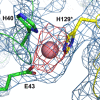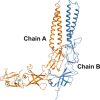Can the propensity of protein crystallization be increased by using systematic screening with metals?
- PMID: 28643473
- PMCID: PMC5563152
- DOI: 10.1002/pro.3214
Can the propensity of protein crystallization be increased by using systematic screening with metals?
Abstract
Protein crystallization is one of the major bottlenecks in protein structure elucidation with new strategies being constantly developed to improve the chances of crystallization. Generally, well-ordered epitopes possessing complementary surface and capable of producing stable inter-protein interactions generate a regular three-dimensional arrangement of protein molecules which eventually results in a crystal lattice. Metals, when used for crystallization, with their various coordination numbers and geometries, can generate such epitopes mediating protein oligomerization and/or establish crystal contacts. Some examples of metal-mediated oligomerization and crystallization together with our experience on metal-mediated crystallization of a putative rRNA methyltransferase from Sinorhizobium meliloti are presented. Analysis of crystal structures from protein data bank (PDB) using a non-redundant data set with a 90% identity cutoff, reveals that around 67% of proteins contain at least one metal ion, with ∼14% containing combination of metal ions. Interestingly, metal containing conditions in most commercially available and popular crystallization kits generally contain only a single metal ion, with combinations of metals only in a very few conditions. Based on the results presented in this review, it appears that the crystallization screens need expansion with systematic screening of metal ions that could be crucial for stabilizing the protein structure or for establishing crystal contact and thereby aiding protein crystallization.
Keywords: combination of metals in crystallization; crystallization screens; metals in crystallization; protein crystallization.
© 2017 The Protein Society.
Figures





References
-
- Dauter Z (2002) New approaches to high‐throughput phasing. Curr Opin Struct Biol 12:674–678. - PubMed
-
- Chayen NE (2004) Turning protein crystallisation from an art into a science. Curr Opin Struct Biol 14:577–583. - PubMed
-
- Chayen NE, Saridakis E (2008) Protein crystallization: from purified protein to diffraction‐quality crystal. Nat Methods 5:147–153. - PubMed
-
- Ochi T, Bolanos‐Garcia VM, Stojanoff V, Moreno A (2009) Perspectives on protein crystallisation. Prog Biophys Mol Biol 101:56–63. - PubMed
Publication types
MeSH terms
Substances
LinkOut - more resources
Full Text Sources
Other Literature Sources

